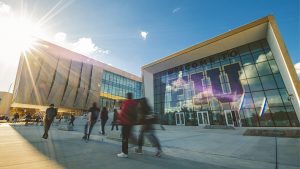Latin America and the Middle East have an expanding, yet limited partnership.
On December 17, 2010, Mohamed Bouazizi, a Tunisian vegetable peddler, set himself on fire when officials in his town prevented him from selling his goods on the streets of Sidi Bouzid without permission. This one tragic act set off a chain reaction of popular protests against authoritarianism and ignited civil strife throughout the Arab world, from Egypt and Libya to Syria, Bahrain and Yemen.
While there is no end in sight for what has been dubbed the “Arab Awakening,” events in North Africa, the Middle East, and the Persian Gulf States have captured the attention of people the world over, far from the conflict areas. Latin America is no exception.
While much has been reported about the political dimension of Arab and Iranian relations with Latin America, the economic dimension has not been widely addressed. It is worth examination, however, since both volatility and opportunity in the Middle East can affect Western Hemisphere nations.
Trade
During the last decade total merchandise trade between Latin America and the Middle East has tripled, exceeding $25 billion with well over half consisting of exports from Latin America. The Gulf States’ trade with the region stands at more than $5 billion. Brazil and Argentina are the Middle East’s largest Latin American trade partners, with commodities dominating bilateral commerce. However, manufactured goods and services (e.g., Marcopolo buses from Brazil, Techint engineering services from Argentina) have steadily grown in recent years. In 2010 Egypt (Latin America’s largest Arab trade partner) signed a free trade agreement with Mercosur. With trade currently standing at a little more than $2.5 billion per year, that amount is expected to triple in the next several years. Mercosur’s leading exports to Egypt are soybean oil, sugar, corn, iron ore, soybeans and frozen beef, while imports consist of phosphates, urea, coal, light petroleum and chemical fertilizers.
It is important to note that “commodity swaps” comprise the majority of Latin America’s trade with the Middle East. Where merchandise and services come into the picture, it is overwhelming dominated by Latin American exports. However, “nostalgia” exports from the Middle East—especially from Lebanon and Syria, the ancestral homelands of the majority of the 20 million Latin Americans of Arab ancestry—comprise no small portion of merchandise trade.
Investment

Capital flows between the Middle East and Latin America are growing. With growth now slowed in the developed markets, corporate and investment leaders based in the Middle East are increasingly looking to Latin America for yield, diversification and access to vital commodities—securing raw materials such as iron, copper, agricultural land and food crops. For example, Saudi Arabia established an $800 million investment in overseas land.
Following the first Arab-Latin American Summit in 2005, the commercial as well as political relationship between the two regions increased significantly, with business delegations visiting both regions. In 2009, the Gulf Latin Leaders Council was inaugurated. Not surprisingly, the main actors have been sovereign wealth funds from the Gulf States—ADIA of the United Arab Emirates, investment groups from Abu Dhabi such as Al Qudra Holding, and Qatar, and the investors in DP World, the port operator that participated in the port expansion of Callao in Peru. Brazil has been the major market for two-way investment. For example, in 2009 Abu Dhabi Investment Authority undertook construction of two towers in Rio, and Aabar Investments invested $328 million in the initial public offering of Banco Santander of Brazil. Petrobrás will be assisting Iraq in increasing refining capability, and mining giant Vale do Rio Doce has plans to establish a $1.4 billion iron ore pellet plant in Oman.
Unfortunately, many planned as well as actual investment activities between Latin America and the Middle East are politically-driven and involve authoritarian and rogue regimes—most notoriously, Venezuela and Iran. For example, Iranian banks have been using Venezuela’s national development bank to fund Hezbollah, Hamas and other terrorist groups. Iran has also promised hundreds of millions of dollars in aid and investment to Nicaragua, Ecuador and Bolivia—three countries that are not exactly stellar examples of democratic governance, liberty and free markets. Syria is another example, with its interest in Venezuela’s oil industry. In 2010, Venezuela, Chavez and Syria’s President Bashar al-Assad signed an agreement for a $100 million trade and development fund as well as a host of bilateral agreements.
One can only hope that the currents of political and economic democracy inundate North Africa, the Middle East, Iran and the Persian Gulf States, as Latin America will surely benefit from greater, closer and more diverse commercial relations with those regions of the world. In the meantime, one should adopt a realistic view of the Latin American-Middle East commercial relations. Trade represents less than 1.5 percent of both regions’ international commerce, with Brazil, Argentina and Mexico accounting for the vast majority of Latin America’s share. Moreover, with sharp credit rating drops in the Middle East and an outflow of large investment from that region, Latin American exporters are extremely concerned about both their overvalued local currencies and declining demand from shrinking economies in the Middle East. However, as the great Lebanese-American poet Khalil Gibran exclaimed: “When hope is lost, nothing remains.” One can only hope that the future—political and economic—for both regions will be a brighter one.
Jerry Haar is a professor of management and international business and an associate dean at FIU’s College of Business Administration. The opinions expressed in this column are the writer’s and do not necessarily reflect the views or opinions of either FIU or the College of Business Administration.
View all articles by Jerry Haar.
This column originally appeared in Latin Business Chronicle on April 20, 2011.




